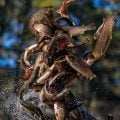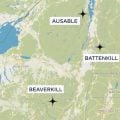How to Tie an Isonychia Parachute
Producer: Tim Flagler
This Isonychia Parachute is one of my guilty pleasure fly patterns – it’s big, easy to tie, and towards dark, throughout most of the summer and fall, the thing flat-out catches fish.
For a hook, I’m going to use a Lightning Strike DF1 in size 12. Begin by getting the hook firmly secured in the jaws of your tying vise.
For thread, I like wine-colored UTC 70 Denier. After loading your bobbin, get the thread started on the hook shank an eye-length behind the eye and take a few wraps rearward before snipping off the tag. Keep taking thread wraps rearward until your thread hangs at about the midpoint of the shank.
Moose body hair is used to form the tail of the fly. Snip a dozen or so hairs free from the hide. Strip out any fuzzy stuff or short hairs from the butts and then give them a little stacking to align the tips. I like to then snip the extra-long butt ends off and give the hair yet another stacking in a smaller stacker. Although not absolutely necessary, this second stacking really helps to get all the tips aligned and concentrate the hair into a narrow, easy-to-manage bundle.
Measure the hair to form a tail a hook shank in length then transfer that measurement rearward to the start of the hook bend. Take wraps of tying thread to bind the hair to the top of the hook. Pulling slightly up on the hair as you do this will help to keep it on top of the shank. Bind the hair down all the way to the start of the hook bend. It’s ok, in fact preferable, if it flares just a little bit. Wrap forward with your tying thread up the hook shank to about its midway point then pull the butt ends of the moose hair up and snip them off close. Take a few more wraps of tying thread to cover the butt ends then leave the thread there at about the 1/3 point on the shank.
Light grey polypropylene yarn is used for the wing or post of the fly. Snip a card-width segment free and then snip that segment in half. This will be enough to make two flies. Take one of the segments and place it on top of the hook shank so the majority of it sticks out past the hook eye. Start taking wraps of tying thread to bind the yarn to the top of the shank. Keep wrapping forward and checking until the material is bound down all the way to two full eye-lengths behind the hook eye. Then lift the back end of the yarn up and snip it off at a shallow angle. This will allow you to take thread wraps rearward, down to the hook shank, creating a nicely tapered underbody in the process.
Fine & Dry Isonychia-colored dubbing is used to create the body of the fly. Take an ample clump from the packet. Pull down to expose 5” of tying thread then use the dubbing to create a nice thin noodle about 4” in length. Take wraps with the noodle so the dubbing begins right at the base of the tail then make touching wraps forward creating a carrot-shaped body on the fly. When you reach the wing post, pull it back and build up a dam with the dubbing noodle in front of it to hold it in the vertical position. Finish by taking a full clockwise wrap or two around the base of the wing post. Then, get hold of the fly and reorient it in your vise so the hook eye is pointing down. Brace the fly with your left hand and take a few more wraps of tying thread to start the posting process.
A single medium dun hackle feather is used to hackle the fly. Measure to make sure the fibers are a size 12, then pull the feather free from the skin. With the shiny side of the feather facing you, strip off the lower webby fibers. Take a few more fibers off the top of the stem to help it orient correctly during the first wrap then snip the stem off leaving about 1/8”. Place that 1/8” against the post like so and start taking wraps to secure it. Generally, the added structure of the stem and the horizontal orientation of the post will make the whole process of posting much easier than normal. End with your thread at the base of the post then get hold of the hackle and start making clockwise wraps with it up the post. Leave a small space between each wrap. When you reach the top of the post, start heading back down with hackle wraps, placing them in the open spaces as you go. When you reach the base of the post, take two or three thread wraps around it to secure the hackle feather. Then get hold of the fly and return it to its normal orientation in your tying vise.
Reach in with the very tips of your tying scissors and snip the excess hackle off as close as possible. Pull all the hackle and the post rearward to expose the hook eye, then take a few wraps of tying thread behind the eye to anchor your thread. Pull the hackle back once again and do a 4 or 5 turn whip finish, seat the knot well and snip your tying thread free. Finally, trim the post to about a hook shank in length. I like to do this at an angle.
As I said earlier, this is a guilty pleasure tie for me mainly because the posting and hackle wrapping procedure is easy and kind of fun. I also really like how well this fly floats and how visible it is on the water’s surface, even well into dark.
How to Tie an Isonychia Harrop's Hairwing
How to Tie an Isonychia Parachute











